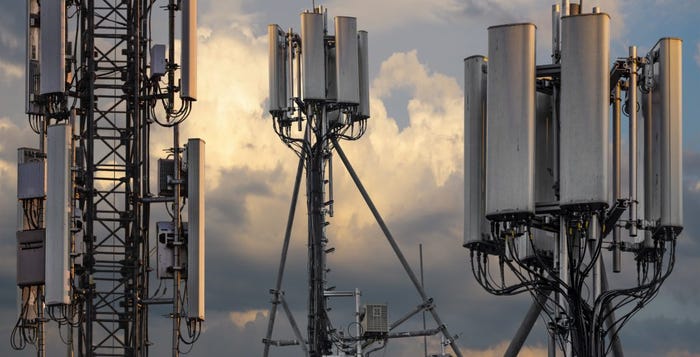A guide to Open RAN
Telecoms.com gathered a panel of industry experts to define and analyse the future trajectory of Open RAN, the approach to building networks from an à la carte menu of equipment manufacturers.
August 14, 2023

Telecoms.com gathered together a panel of industry experts to define and analyse the future trajectory of Open RAN, the approach to building networks from an à la carte menu of equipment manufacturers.
Open RAN is one of those esoteric industry terms that doesn’t tend to escape from Planet Telecoms’ orbit. While your average person on the street might have half a chance of visualising what all the fuss is about with the rise of satellite connectivity, or instinctively understand that 5G is better than 4G because it’s one better, try to start a conversation with them about Open RAN and watch their eyes glaze over.
It is however one of the biggest topics in the industry, not least of which because of the amount of political interest there is in seeing it succeed, prompting substantial and regular sacks of government cash to be deposited upon the heads of those running various Open RAN projects in order to boost it.
Open RAN overview
In a nutshell, Open RAN is an approach to building out mobile networks that makes components from different vendors work together, the idea being an operator can pick a set of manufacturers to work with à la carte when planning infrastructure builds, as opposed to table d’hôte – or getting one of the big kit vendors like Ericsson, Nokia or Huawei to just come in and do the lot.
Since Huawei has been de facto barred from future (and current) telecoms build outs in many Western nations (for reasons usually articulated as security but are also intertwined with the quasi-tech trade war between the US and China) without Open RAN, operators would only really be left with the choice of two – Nokia and Ericsson.
Making the ecosystem of companies more diverse, or allowing the conditions for other firms to come in and increase competition, are the stated drivers for the interest governments in the US and UK and elsewhere have in pushing Open RAN – though the concept is older than the current the current geopolitical tension that has precipitated this interest.
The idealised vision of Open RAN is that multiple components from an influx of new firms who only do bits and pieces of what goes into a 5G tower, for example, can interact in a plug and play type manner by introducing a common language that chips, RANs and RICs can all use. And while the above stated political considerations are very much in play, Open RAN’s advocates argue there are technical benefits to building networks in this way regardless, and that as we approach 6G it will only become more relevant.
To get to the bottom of what Open RAN is, where it came from, the challenges it faces and where it might be in the future, we gathered a panel of industry experts to pick their brains.
What is Open RAN?
First, let’s try some definitions. When asked to pin down the technological distinctions from network infrastructure provided by a single supplier, as opposed to an all-in-one solution that’s been more common today, Professor William Webb, CTO, Access Partnership said:
“Open RAN is where the interfaces within the base station conform to an open standard, allowing different parts of the base station to be procured from different suppliers. It differs from “classic RAN” where only the interfaces from the base station to other parts of the network are open standards (within 3GPP).”
A spokesperson from Orange points out it’s also about specifications: “Specifications for 4G and 5G are delivered by the O-RAN Alliance, a body led by operators (founded in 2018 by ATT, China Mobile, NTT Docomo, Orange, DT). Compared to Open RAN, a traditional RAN network is provided by a single RAN vendor and relies on proprietary hardware processing (Base Band Units) and proprietary versions of interfaces between RAN elements (typically their own implementation of CPRI/eCPRI on the fronthaul interface).
“However, it is also possible for a single supplier to provide a full RAN based on O-RAN (for the purposes of this piece, O-RAN and Open RAN can be used interchangeably) specifications, with a vRAN software operated on their own cloud infrastructure, and radio units compliant with the Open Fronthaul specifications.”
Dr Matteo Fiorani, Head of Distributed Unit & Infrastructure, Ericsson described the differences between the two approaches as this: “The ambition for Open RAN is to allow the separation or disaggregation of hardware and software with open interoperable interfaces and virtualization, and improved intelligence and automation in radio access networks. This could increase the number of suppliers active in the market.
“To break it down, current RAN technology is provided as a hardware and software integrated platform. Whereas the ambition for Open RAN is to create a multi-supplier RAN solution that allows for the separation – or disaggregation – between hardware and software with open interfaces and virtualization, hosting software that controls and updates networks in the cloud.”
Joe Barry, Vice President of Marketing, Systems & Technology in the Communications & Cloud Business Unit at Analog Devices provides an additional example: “A key benefit of Open RAN is giving operators a more nimble network that can add new applications and features from a variety of vendors on a regular basis. Being able to mix and match products from different vendors increases innovation and simplifies network management.
An example of this innovation is the RAN Intelligent Controller, which was added into the stack by the O-RAN Alliance. Among the many opportunities, one is to integrate AI functionality into resource management that will improve overall network energy efficiency, capacity, and allow for new service delivery functions.”

The origins of Open RAN
Open RAN is in its early stages, but its roots are perhaps a little older than you might think. In terms of when and where the concept originated, Webb says: “That’s rather lost in history. The first ideas around more interfaces within the base station came from the Femtocell (later Small Cell) Forum. These didn’t really go anywhere but may have seeded the thinking that led to O-RAN being more widely discussed when supply chain issues started to emerge as Chinese suppliers were barred from core networks.”
Barry says the concept of Open RAN really got going when the process of developing standards began back in 2016: “The concept of open interfaces and open software has been around for quite some time, but the first effort to develop Open RAN standards and networks started with xRAN Forum in 2016, with several MNOs including AT&T, Deutsche Telecom, NTT Docomo, and Verizon as founding members. The C-RAN Alliance, led by China Mobile and focused on virtualizing the RAN, merged with xRAN in 2018 to form the O-RAN Alliance, which is the organization developing Open RAN standards. The Telecom Infra Project (TIP), also founded in 2016, has been focused on commercializing Open Radio Solutions.”
Later, the O-RAN Alliance emerged on the scene. Fiorani says: “The creation of the O-RAN Alliance was announced at MWC in February of 2018, with the first work group meetings and symposium held in September of that year. The guiding principles of the Alliance are to lead the industry towards open, interoperable interfaces and RAN virtualization. Ericsson was accepted as a member in December of 2018 and we hold two co-chair positions.”
Government interest in Open RAN
So that’s what the technology/approach to building networks called Open RAN is in a nutshell, but part of why it’s such a hot topic in the telecoms market is that governments around the world have taken such a public position on promoting it, and in backing that up with significant funding initiatives. Why do they do this?
“Predominantly because governments want to increase supply chain diversity – they want more suppliers of telecoms equipment,” says Webb. “Quite why is not clear, but it is likely that they are trying to compensate for having reduced the number of suppliers through their actions with Chinese vendors. Governments discuss factors like improved security with more vendors, but have not explained why this should be so. Some governments are also keen to use O-RAN as an opportunity to grow national capabilities in telecoms supply.”
Barry adds: “While the specific motivations and interests of governments may vary, it’s generally seen as a promising approach to enhance competition, foster innovation, and enable more flexible and cost-effective deployments of wireless networks. With greater network capabilities, countries are better equipped in the global tech-arms race, to inspire local innovation, economic growth and fuel job creation. Open RAN can even contribute to national security by making us less vulnerable to potential disruptions or malicious activities.”
Our Orange spokesperson points out that various countries may have their own individual agendas for wanting to push Open RAN: “One of the major points to consider here is the willingness from governments / states to ensure a regional sovereignty on technology and create / develop a local industry/ecosystem of RAN vendors, taking benefit from the “birth” of the open RAN concept.
“In the US, it is considered that the two heavyweights Ericsson and Nokia are European players, and as such, the sovereignty of the US in the telecom domain is at risk. In Japan, two RAN local players (NEC and Fujitsu) plan to become global suppliers thanks to their open RAN portfolio.
“In Europe, funding such as the IPCEI initiative (on MicroElectronics & Communication Technologies and on Cloud Infrastructure & Services) aims at stimulating a local Open RAN ecosystem to counterbalance initiatives from other regions.”

How big is Open RAN right now?
In terms of the current state of development of Open RAN in the real world – as opposed to trials and lab demonstrations – just how many deployments have there to date and how much of the telecoms infrastructure market might it account for in the future?
Webb says: “Broadly O-RAN is being deployed in rural areas and less demanding sites (those with a small number of carriers and relatively few antennas). It still appears that it is not ready for deployment on the more demanding sites such as those in city centres and those which have multiple generations of cellular technology (2G, 3G, 4G, 5G). Others are better placed to comment on what market share it might gain but broadly only a small fraction of the 5G market but, depending on standardisation, more of the 6G market.”
Open RAN deployment is increasing
Our Orange spokesperson says that while brownfield deployment numbers are low, that will change in the future: “Open RAN deployments are gradually ramping up and new specifications are regularly being updated (the latest one being released in February this year).
Orange plays a key part in these updates and as a founding member of the O-RAN Alliance, we have been very active for several years on the development of Open RAN. We have the ambition to have 100% of our equipment compatible with Open RAN by 2025.
��“As part of this, we launched in June 2021, Pikeo, the first cloud-native experimental network in Europe, which has provided us with invaluable experience and knowledge on the automation of cloud native 5G SA networks and demonstrated the growing maturity of the Open RAN technology.
“Other greenfield and brownfield deployments by other operators have also taken place over the past couple of years by Rakuten, 1&1 Drillisch, Dish Wireless, NTT Docomo, Verizon, Vodafone, DT and Telefonica. While commercial roll-out at scale have mainly taken place with greenfield networks, most brownfield deployments are still small scale, but we expect to see rapid growth in the coming years.”
When it comes to revenue share, Fiorani says: “According to its research report published in January 2023, Dell’Oro projects that Open RAN revenues projected to approach for 18% of the overall RAN market by 2027, and vRAN including radios – 22%.”
Open RAN expansion
“We also need to keep in mind that we are still in the early days of the broader Open RAN transition, especially with regard to brownfield networks,” continues Fiorani. “Therefore, there are presently few multivendor Open RAN large-scale deployments. The most notable one is from an operator in Japan, while other deployments around the globe are smaller scale or trials. There are also large-scale deployments of Cloud RAN networks where all network functions are provided by the same vendor, including, for example, one in North America.”
Barry adds that while it’s a slow burner, expansion of the Open RAN footprint is inevitable: “We’re past the hype phase and are seeing serious Open RAN deployments. Japan and Deutsch Telecom were first out of the gates, and now other European telcos are launching installations. For example, in Germany, 1&1 and Deutsche Telekom, and Vodafone in the UK recently launched sites.
“The movement is global, with India making great strides, both in the operator community and its domestic open vendor ecosystem. Meanwhile, in Japan, NTT Docomo has promised to have a competitive Open RAN solution on the market by the end of the year. Open RAN has deployed in greenfield, but with further innovations and investment, brownfield could gain momentum soon. It’s a slow burner, and traditional operators will take longer to move, but we are seeing movement.
“By now, I suspect all operators are examining Open RAN, and have some idea how they are going to proceed. From our perspective, Open RAN is inevitable. I foresee many of the current Open RAN definition being adopted as part of 3GPP and becoming part of 6G standards.”

The challenges to Open RAN
While its advocates are bullish on the long-term success of Open RAN, there are some challenges in short to medium term expansion.
Of these, Webb says: “The main challenge is that operators are wary of introducing new vendors into their network because of the integration effort, the time taken to learn about the new equipment, and the risk it does not perform well in an existing network. They may also be concerned about the longevity of some O-RAN vendors. Hence, there needs to be a significant advantage in O-RAN which is not currently apparent. There are no particular downsides beyond the effort of integration.”
Stability of Open RAN
Furthermore, Fiorani notes that at the present moment, Open RAN may not be sufficiently stable or secure for certain critical applications: “Open RAN has high potential, and to ensure its future success, improvements in energy, performance and security are needed. Mobile networks, as a vital national infrastructure must be resilient, open, sustainable, and intelligent, to support business and mission critical use cases. For many mission critical applications, multi-vendor Open RAN is not yet sufficiently stable, secure or mature.
“Maintaining benefits of global scale is also critical for industry and users. It is key for investment and innovation in the future networks and to maintain the world’s largest open innovation platform to all.”
Open RAN deployment
While remaining confident about Open RAN, our Orange spokesperson does acknowledge certain factors are hindering deployments, though insists its not holding them back: “Orange Spokesperson: First, we believe that there are no major challenges holding back Open RAN deployments today, as Open RAN is becoming a reality in the market. While non-complex configurations deployable in rural areas are mature, large-scale nationwide deployments will require a wider range of products, including full support of Massive MIMO, multi-band Radio Units and specific combinations of bands, which may require further market commitments from operators.
“Another factor hindering large scale deployments in Europe is the modernisation cycle of RAN, since the first wave of 5G deployment has relied so far on traditional RAN. A second wave is expected within the next few years, leading to new opportunities for a larger scale adoption of Open RAN in commercial deployments.
Open RAN integration issues
“Deployments at scale will also require industrializing a robust system integration process across the industry. Indeed, one of the main challenges of the Open RAN approach is the additional integration effort which is needed to build a full Open RAN based on O-RAN components and interfaces. With traditional vendors, the integration process is somehow hidden to operators. In an Open RAN perspective, it may be managed by operators themselves, RAN Software providers or by third party System Integrators. The management of multi-vendor system integration may be eased by a strong and universal certification framework.”
Barry adds: “Open RAN is a significant technical lift, and the O-RAN alliance has only been around for a few years. Technical issues around standards, like the 3GPP, are ongoing. With the Open Radio Unit specifications, while Macro and Small Cell radio unit functional requirements have been settled, Massive MIMO’s radio functionality is still being drafted. The RAN Intelligent Controller also needs further definition.
“Another challenge is the time it will take for emerging vendors to develop solid solutions and catch up in a highly competitive market. And even if they were on equal footing, many operators, including the Big Five, are still in contracts with existing vendors. Finally, operating a mobile network is highly energy-intensive, and if Open RAN can’t get close to energy parity, it will have a difficult time.”
In conclusion, there is a lot of pressure from governments and buy in from many industry players to see Open RAN take off in a greater way, however there are some obstacles to be overcome if that is to happen, and the whole endeavour may be more integrated into the 6G generation of telecoms networks.
For a more general explanation of networks check out our deep-dive on What is 5G? And for predictions on the what the industry thinks is on the horizon see What is 6G?
Get the latest news straight to your inbox. Register for the Telecoms.com newsletter here.
Read more about:
Tech ExplainersAbout the Author(s)
You May Also Like








.png?width=300&auto=webp&quality=80&disable=upscale)


_1.jpg?width=300&auto=webp&quality=80&disable=upscale)


.png?width=800&auto=webp&quality=80&disable=upscale)